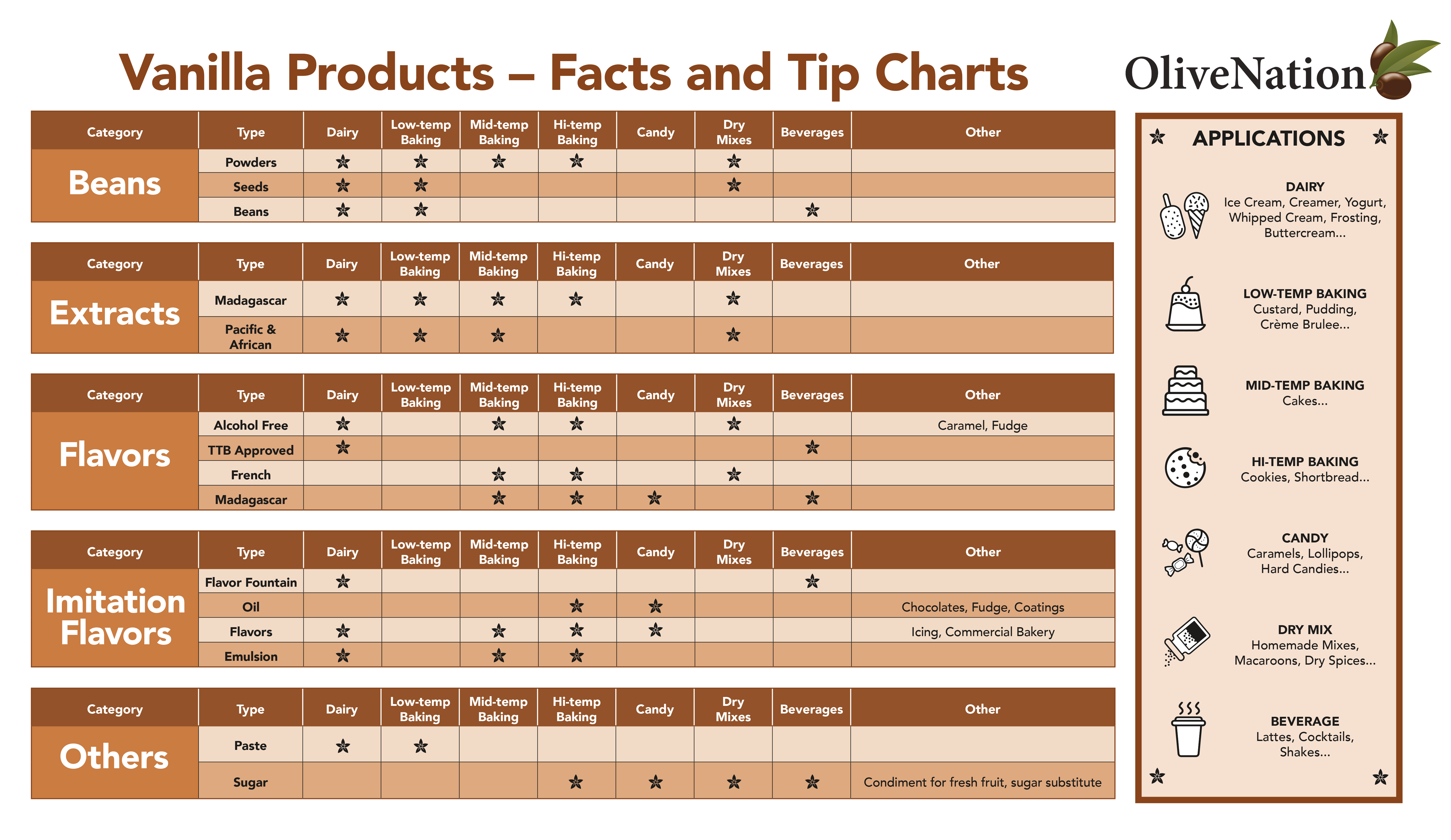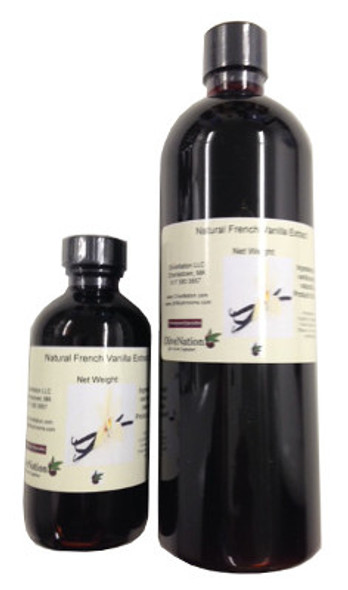Vanilla
-
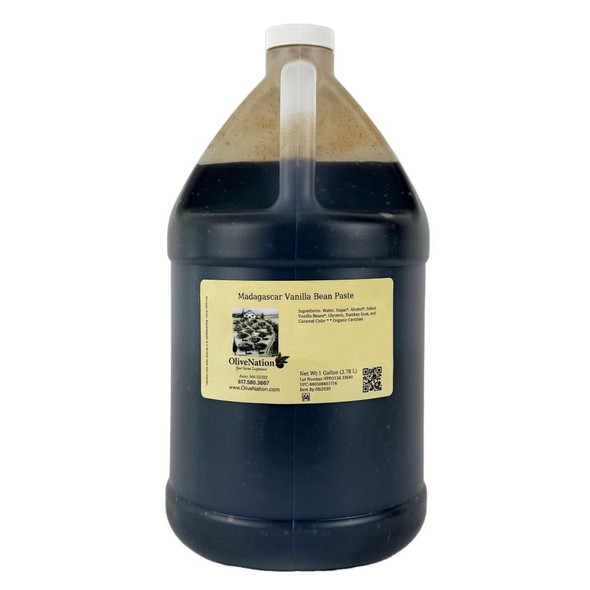

Madagascar Vanilla Bean Paste
OliveNation
$11.99Madagascar Vanilla Paste - Extract Substitute with Real Vanilla Bean Seed FlecksReal Bourbon Vanilla Beans and Vanilla Extract in a Xanthan Gum BaseThick, Syrup-Like Texture with Flecks of Vanilla Bean SeedsAdds Rich, Deep Taste, Aroma, and Look of Real...$11.99 -
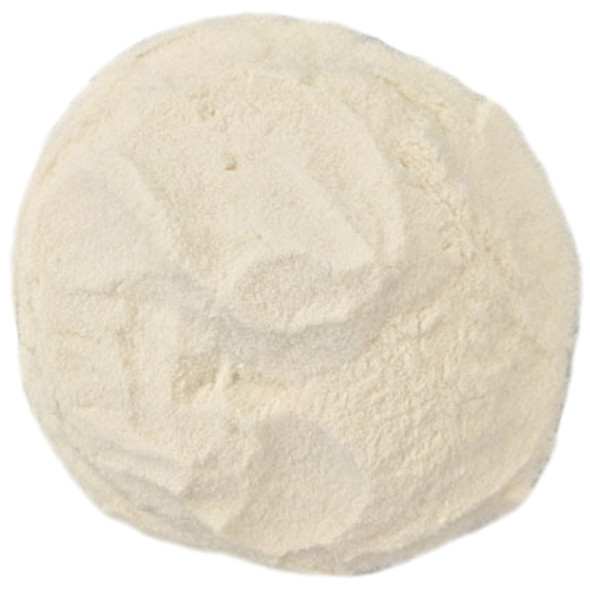
Organic Vanilla Powder
OliveNation
$11.99Formula Updated: 1/12/2018Organic Vanilla Powder - 100% Natural Vanilla Powder for Cooking, Baking & MixesOrganically Grown Bourbon Madagascar Vanilla Bean Extractives in Organic Sugar Cane BaseLight, Powdery Formulation with Rich Vanilla TastePerfect...$11.99 -


Madagascar Bourbon Natural Vanilla Flavor, 2 Fold
OliveNation
$11.99Double Fold Bourbon Vanilla Flavor with Concentrated Taste & Aroma2x Flavoring from Grade A Madagascar Bourbon Beans, Caramel Color & Natural FlavorsAlcohol Base with Glycerin is Ideal for Baking, Cooking & Dairy ProductsRich & Creamy Vanilla Taste &...$11.99 -
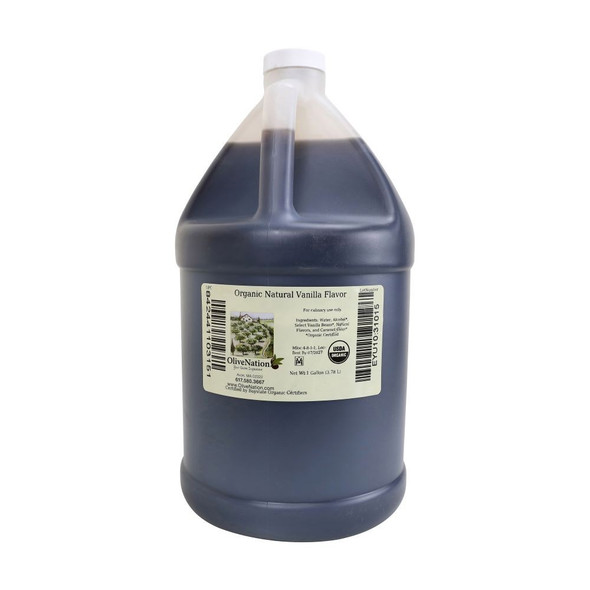

Organic Natural Vanilla Flavor
OliveNation
$12.99Organic Vanilla Flavor - 100% Natural Water Soluble Flavoring from Real Vanilla BeansCertified Organic Vanilla Extract with Natural Caramel ColorAdds Delicious, Creamy, Slightly Floral Taste & Aroma to Baked Goods & DishesEnhances and Balances other...$12.99 -
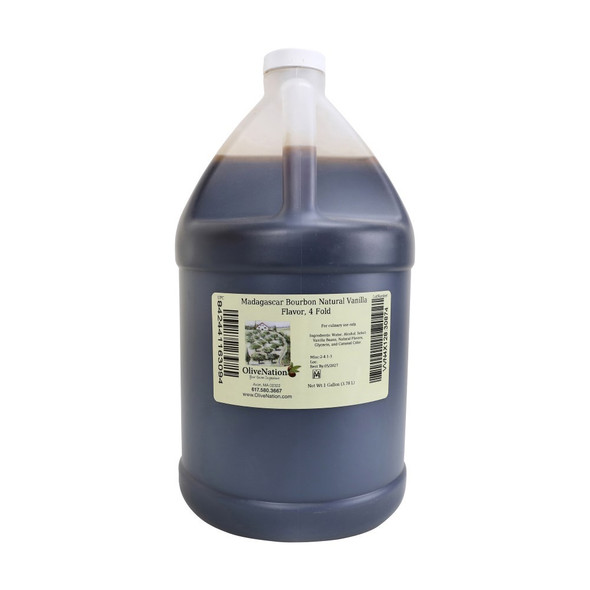

Madagascar Bourbon Natural Vanilla Flavor, 4 Fold
OliveNation
$11.99Four Fold Natural Madagascar Bourbon Vanilla Flavor for Baking, Beverages, Brewing4x Flavoring Made Using Grade A Madagascar Bourbon Beans, Caramel Color & Natural FlavorsAlcohol Base with Glycerin Ideal for Mid and High-Temp Baking & Cooking...$11.99 -
On Sale

Prova Vanilla Flavored Cocoa Butter
Now: $90.99Was: $100.99Vanilla Flavored Cocoa Butter for Chocolates, Confections, Coating, BakingIngredients: Cocoa Butter, Papua New Guinea Vanilla FlavorEasy to Use Flavor-Infused Formulation Adds Rich Vanilla TastePerfect for Making Flavored Chocolates, Coatings, Fillings,...Now: $90.99Was: $100.99 -

Set of 6 Vanilla Extracts
OliveNation
$51.99Vanilla Set - Six Extracts & FlavorsSet of Six Different Vanilla Extracts & Flavors - 4oz EachGreat Way to Experiment with Different Vanilla Flavor ProfilesMix of Vanilla Types including Madagascar (Bourbon) & Tahitian (PNG)Includes Organic, Alcohol...$51.99 -


Alcohol Free Vanilla Flavor
OliveNation
$14.99Alcohol Free Vanilla - Concentrated Flavoring for Baking & Candy MakingVanilla Extract with No Alcohol = Vanilla EmulsionReal Vanilla Bean Extractives in Glycerin Base with Xanthan GumThick, Syrupy Consistency & Sweet, Rich Vanilla Taste & AromaAlcohol...$14.99 -


Organic Ground Vanilla Bean Powder
OliveNation
$61.99Vanilla Bean Powder - 100% Pure Ground Bourbon Vanilla PodsDried & Ground Madagascar Bourbon Beans with SeedsFine Powdery Texture with Rich Vanilla Flavor and AromaAdds Flavorful Dark Brown Flecks to Baked Goods & DessertsNo Additives, Sugar, or...$61.99 -


Organic Extracted Vanilla Bean Seeds
OliveNation
$28.99Extracted Vanilla Seeds - Flavorless Real Vanilla Specks for Commercial/Industrial ApplicationsFlavorless Dark Brown Seed Specks From Extracted Vanilla BeansNo Taste or Aroma - Adds Visual Interest for an Authentic LookPerfect for Use in Ice Cream,...$28.99 -


Organic Madagascar Vanilla Beans - Grade A, Chopped
OliveNation
$61.99Madagascar Vanilla Bean Cuts - Chopped Bourbon Beans for Brewing & Extract MakingReal Madagascar Bourbon Beans with Seeds Chopped into Irregular PiecesPerfect for Creating Richly Flavored, Aromatic Extracts, Beer, Wines, Distilled BeveragesAdds Classic...$61.99 -
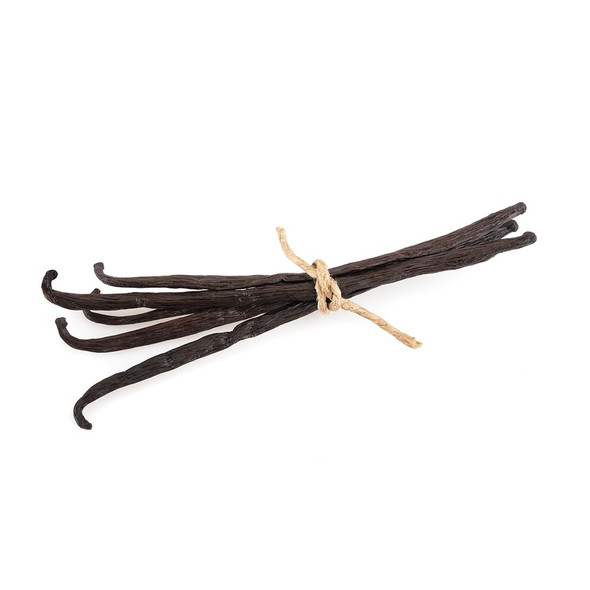

Organic Madagascar Vanilla Beans - Grade A
OliveNation
$9.99Organic Vanilla Beans - Distinctive Rich, Creamy, Buttery Flavor & AromaCertified Organic Dried Whole Bourbon Vanilla Seed PodsMadagascar-Grown Beans Are Perfect for Any RecipeClassic Vanilla Taste & Aroma - Rich, Buttery, Creamy FlavorNon-GMO, Gluten...$9.99 -


Organic Madagascar Vanilla Beans, Short
OliveNation
$15.99Short Madagascar Bourbon Vanilla Beans for Extracts, Baking, CookingGourmet Quality Vanilla Pods Approximately 13 cm/5 inches LongPlump, Juicy Dried Pods with Deep Vanilla Aroma & FlavorPerfect for Baking, Cooking, Extract MakingCertified Organic...$15.99 -

Organic Papua New Guinean Vanilla Beans
OliveNation
$10.99Papua New Guinea Tahitian Vanilla Beans - Whole Vanilla Pods (Tahitiensis) PodsGrade A Whole Tahitian Vanilla Beans from Papua New GuineaSweet, Floral Fragrance and Deep, Fruity TasteRich Undertones Complement Cream or Fruit Desserts, Savory Seafood or...$10.99 -

Tongan Vanilla Beans
OliveNation
$13.99Tongan Vanilla Beans - Intense, Bold Vanilla with Floral & Fruit UndertonesGrade A Vanilla Pods Grown & Harvested in TongaIntense Floral & Fruit Notes with Undertones of Red Wine, Figs, CherriesIdeal for Use with Strong Flavors - Fruit Desserts,...$13.99 -


Ugandan Vanilla Beans
OliveNation
$17.99Ugandan Vanilla Beans - Whole Dried Pods with Bold, Rich Taste for Baking & CookingPlanifolia Vanilla Pods Grown & Harvested in UgandaSmooth, Creamy Taste with Deep UndertonesPerfect for Balancing Strong FlavorsNon-GMO, Gluten Free, Kosher,...$17.99 -
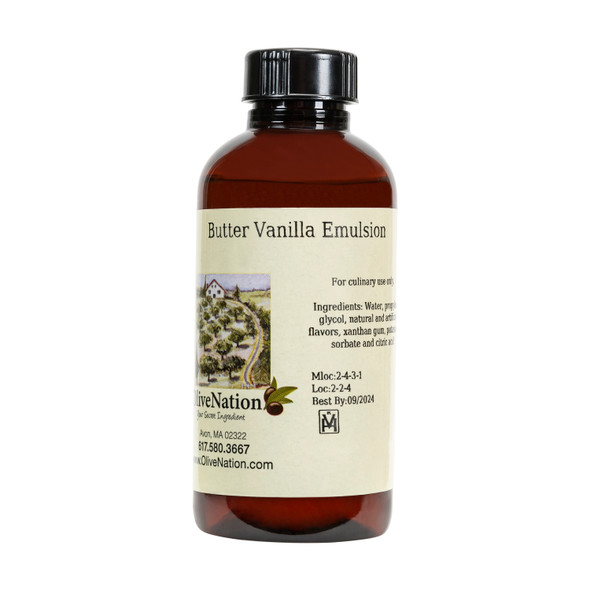

Butter Vanilla Emulsion
OliveNation
$9.99Butter Vanilla Bakery Emulsion - Deep, Rich Flavoring will not Bake OutWater-Based Flavoring Ideal for High-Heat & No-Heat ApplicationsRich, Buttery Vanilla Taste & Aroma from Natural & Artificial FlavorsPerfect for Boosting Vanilla Flavor or Adding...$9.99 -
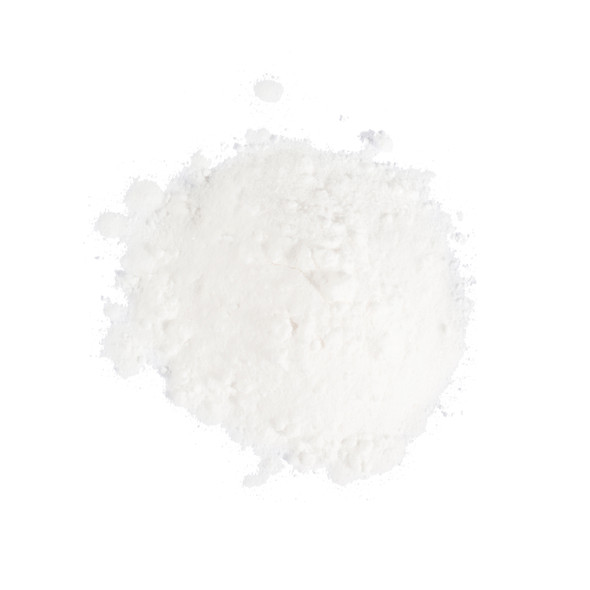
Butter Vanilla Flavor Powder
OliveNation
$12.99Butter Vanilla Flavor Powder Adds Luxe Flavor Boost To RecipesAdds Taste and Aroma of Both Butter and Vanilla to Bakery CreationsGreat Replacement for Liquid ExtractsShelf Stable for Up to 12 Months - Ideal for Commercial MixesWater Soluble, Non-GMO,...$12.99 -


Madagascar Bourbon Natural Vanilla Flavor
OliveNation
$11.99Natural Vanilla Flavor - Economical Flavoring for Commercial & Industrial Food ApplicationsMade using Grade A Madagascar Bourbon Beans with Caramel Color & Natural FlavorsAlcohol Base with Glycerin is Ideal for At-Scale Baking, Cooking, Dairy...$11.99 -


Madagascar Bourbon Natural Vanilla Flavor, 3 Fold
OliveNation
$12.99Triple Fold Vanilla for Flavoring Baked Goods, Beverages, CookingTriple Strength Flavoring made from Grade A Madagascar Bourbon Beans, Caramel Color & Natural FlavorsAlcohol and Glycerin Base Ideal for Mid and High-Temp Baking & CookingThree Times...$12.99 -


Tahitian Natural Vanilla Flavor
OliveNation
$11.99Tahitian Natural Vanilla Flavor - Deep, Fruity & Floral Taste & AromaAlcohol-Based with PNG Tahitian Vanilla Bean ExtractivesNatural Flavors & Caramel Color for Delicious Fruity Vanilla Aroma & FlavorPerfect for Pastry & Baking Applications - Cookies,...$11.99 -

French Vanilla Flavor Fountain
OliveNation
$12.99French Vanilla Flavoring for Ice Cream, Beverages, Whipped ToppingMade Using Natural & Artificial Flavors for Authentic Creamy Vanilla TasteAdds Taste, Aroma & Rich Brown Color to Recipes and BeveragesWater-Soluble Formulation Ideal for Beverages & Baked...$12.99 -
Out of stock


French Vanilla Extract - Natural
OliveNation
$13.99French Vanilla Natural Flavor - Made with Real Vanilla Bean Extractives for Deep, Creamy TasteMade using Vanilla Bean Extractives & Natural FlavorsSubstitute for Regular Vanilla Extract for Deeper, Creamier, Richer TastePerfect for Adding Depth and...$13.99 -


Imitation Vanilla Flavor
OliveNation
$9.99Imitation Vanilla Flavor - Dark Brown Flavoring for Baking, CandyAlcohol-Free & Gluten Free Extract Alternative with Authentic Vanilla Taste, Aroma & ColorMade from Water, Glycerin, Vanillin, Ethyl Vanillin, Caramel ColorPerfect for High Temperature...$9.99 -


Imitation Vanilla Flavor - Clear
OliveNation
$9.99Clear Imitation Vanilla for Pure White Cakes, Icing & FrostingAlcohol-Free & Sugar Free Extract Alternative with Authentic Vanilla Taste & AromaColorless Liquid Flavor Made from Water, Propylene Glycol, Vanillin, Ethyl VanillinPerfect for Wedding Cake,...$9.99 -


Imitation Vanilla Flavor, 10 Fold - Clear
OliveNation
$9.9910-Fold Clear Imitation Vanilla Flavor10x Flavoring Made from Water, Alcohol, Propylene Glycol, Vanillin, Ethyl Vanillin, natural FlavorsColorless Water Soluble Liquid with Concentrated Vanilla Taste & AromaPerfect for Flavoring Pure White Wedding Cakes,...$9.99 -
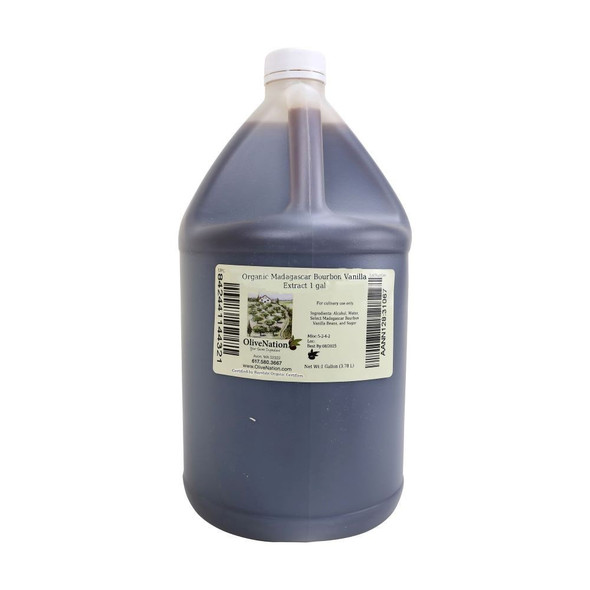

Organic Madagascar Bourbon Vanilla Extract
OliveNation
$19.99Certified Organic Madagascar Bourbon Vanilla Extract with Added Sugar for Delicious Baked Goods & Dairy ProductsMade From Alcohol, Water, Sugar & Top Quality Red Foxy Bourbon Beans from MadagascarSweet, Creamy, Floral Taste with Delicious Vanilla...$19.99 -


Organic Madagascar Bourbon Pure Vanilla Extract
OliveNation
$18.99Organic Pure Vanilla Extract - Professional Quality Madagascar Bourbon Vanilla FlavoringMade From Alcohol, Water & Top Quality Red Foxy Bourbon Beans from MadagascarCreamy Floral Taste and Potent Aroma Complement & Enhance Other FlavorsIdeal for Use in...$18.99 -
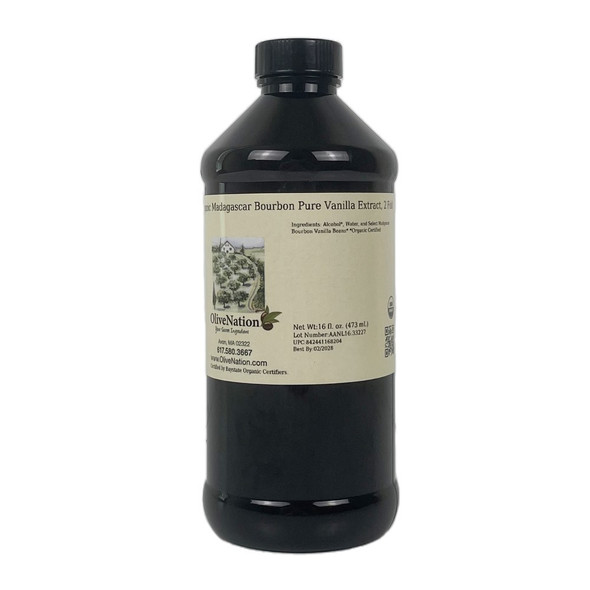

Organic Madagascar Bourbon Pure Vanilla Extract, 2 Fold
OliveNation
$22.99Two Fold Madagascar Bourbon Pure Vanilla Extract - 2x Strength, Certified OrganicDouble Fold Extract Made From Alcohol, Water & Top Quality Red Foxy Madagascar Bourbon BeansPerfect for Balancing & Enhancing Flavors in Baking, Cooking, Dairy Applications,...$22.99 -

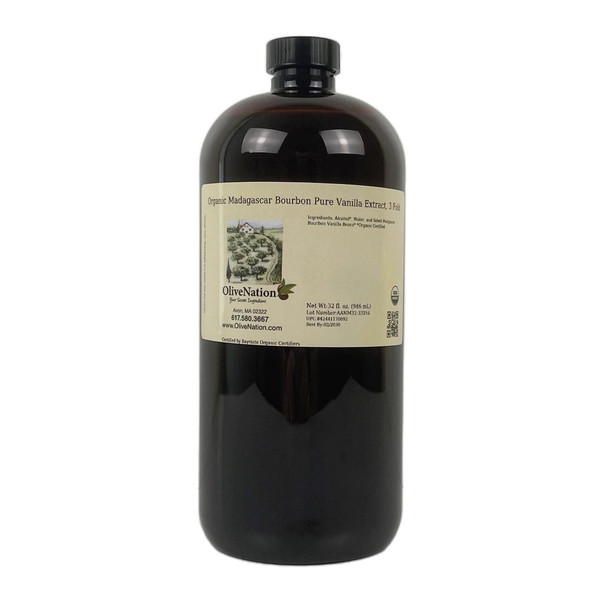
Organic Madagascar Bourbon Pure Vanilla Extract, 3 Fold
OliveNation
$26.99Three Fold Madagascar Bourbon Pure Vanilla Extract - Certified Organic Flavoring at 3x StrengthTriple Fold Extract includes only Alcohol, Water & Superior Red Foxy Madagascar Bourbon Vanilla BeansAdds True Vanilla Taste in Baking, Cooking, Dairy &...$26.99 -


Madagascar Bourbon Pure Vanilla Extract with Seeds
OliveNation
$24.99Madagascar Bourbon Pure Vanilla Extract with Seeds - Pure Crush Vanilla Bean ExtractMade From Alcohol, Water & Madagascar Red Foxy Bourbon Beans and Crushed SeedsAdds Creamy, Floral Vanilla Taste & Aroma to Sweet or Savory RecipesEnhances Flavors and...$24.99 -


Tahitian Vanilla Bean Paste
OliveNation
$19.99Tahitian Vanilla Bean Paste with Seeds for Gourmet Baking & CookingMade from Water, Sugar, Alcohol, Vanilla Beans, Glycerin, Xanthan Gum & Caramel ColorConcentrated Flavor with Thick, Syrup-Like TextureIdeal for Ice Cream, Beverages, Baked Goods,...$19.99 -


Pure Vanilla Bean Extract
OliveNation
$17.99Pure Vanilla Bean Extract - Blend of Bean Varieties for Maximum Vanilla FlavorMade from a Blend of Select Madagascar Beans, Water & AlcoholSugar-Free Flavoring Adds Creamy, Rich Vanilla Flavor & AromaGreat for Baking, Beverage & Dairy ApplicationsSugar...$17.99 -
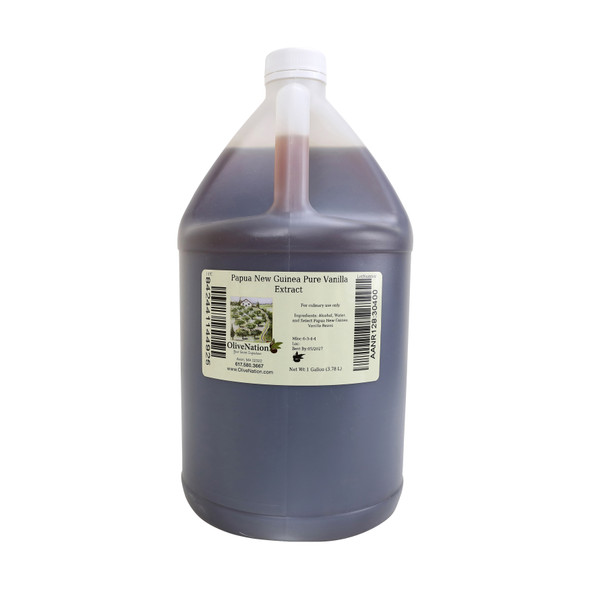

Papua New Guinea Pure Vanilla Extract
OliveNation
$18.99PNG Pure Vanilla Extract - Exotic, Tropical Flavor from Blend of Papua New Guinean BeansMade from PNG-Grown Tahitiensis & Planifolia Beans, Alcohol, and WaterNaturally Sugar Free Flavoring with Exotic Creamy, Floral TasteIdeal for Baking, Beverages, Ice...$18.99 -
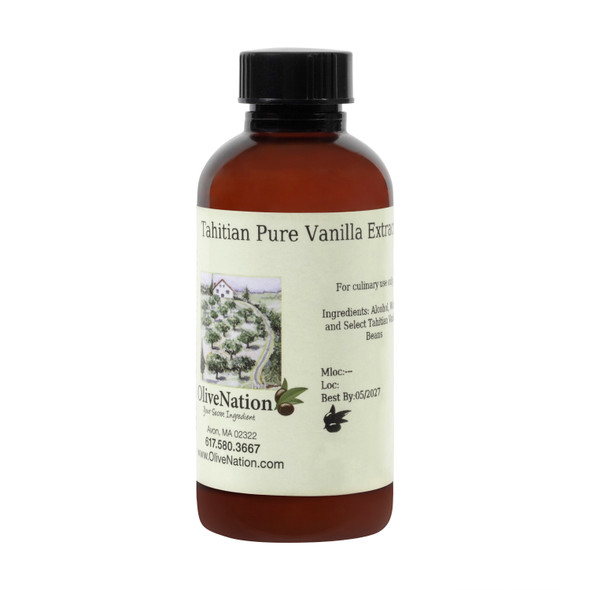

Tahitian Pure Vanilla Extract
OliveNation
$19.99Pure Tahitian Vanilla Extract - Naturally Sweet, Floral, Fruity Flavor & AromaMade from PNG-Grown Tahitiensis Beans, Alcohol, and WaterSugar Free Flavoring with Naturally Sweet, Floral Aroma & TasteDelicate, Delicious Flavor for Baked Goods, Pastry,...$19.99 -


Ugandan Pure Vanilla Extract
OliveNation
$18.99Pure Ugandan Vanilla Extract - Uniquely Deep, Bold Flavor For Baking & CookingMade from Whole Uganda-Grown Beans, Water & AlcoholAdds Uniquely Bold, Earthy, Creamy Taste & AromaPerfect for Baking, Cooking & Dairy ProductsSugar Free, Non-GMO, Gluten Free,...$18.99 -


Vanilla Flavor - TTB
OliveNation
$10.99TTB-Approved Concentrated Vanilla Flavor - Low Moisture FormulationLow Moisture Form Made from Glycerine, Alcohol & Natural FlavorsThick, Syrup-Like Texture for Easy Blending with IngredientsAdds Delicious Vanilla Taste & Aroma to Beer, Wine, Alcopops,...$10.99
Wholesale Vanilla Beans, Extracts, and Powders
Shop OliveNation's wide selection of vanilla for home and commercial baking, cooking, brewing, or industrial food manufacturing. Ranging from top quality vanilla extracts in a variety of strengths to commercial grade vanilla beans, our ingredients are available in multiple size options including bulk commercial quantities for wholesale purchase. Vanilla is one of the most popular flavors across the world, and OliveNation vanilla ingredients allow home and professional chefs, bakers, and brewers to create the flavoring profile they want, using the form and formulation they need. Premium vanilla, such as pure extracts made from Bourbon Madagascar vanilla beans, has a taste and aroma unlike any other. Vanilla from other sources, such as Mexican, Indonesian, or Tongan beans, offers different flavor profiles and is often a more economical choice for bulk purchase for commercial food applications such as mixes, food service, and industrial or institutional use. OliveNation's curated selection of vanilla beans, extracts, emulsions, and flavoring agents offers a variety of options to meet the needs of any chef or home cook.
Types of Vanilla
Wondering how to choose the right type of vanilla for your recipe? Understanding the different types of vanilla and what they are best used for can be challenging. Much like the relationship between grapes and wines, the flavor of natural vanillas is greatly influenced by not just the variety of plant, but the location in which it grows and the ways it is cultivated, harvested, and processed.
While there are only two main varieties of vanilla plants — Vanilla Planifolia and Vanilla Tahitiensis — there are more than 15 nations around the world that produce vanilla beans for commercial use. Of the two varieties, Planifolia offers a stronger flavor with deep, earthy notes while Tahitiensis has a more subtle flavor with floral notes. However, the final flavor of any natural vanilla will depend on where the beans are grown and how they are harvested and processed for use. A third variety of vanilla, Vanilla Pompona, grows natively in Mexico and South America, but is very rare. OliveNation offers a selection of different vanilla products for sale, including beans, extracts, and flavors, from Bourbon and Tahitian varieties grown in a number of different locations:
Tonga Vanilla (Planifolia) -
Tonga is an archipelago of 170 islands located in the southwestern Pacific Ocean. Officially known as the Kingdom of Tonga and sometimes called the "Friendly Islands," Tonga's environment includes both semi-tropical and tropical climates. The lush climate and fertile soil give Tongan Vanilla a deep, unique flavor profile that is both fruity and floral. Undertones of red wine, cherries, and figs allow Tonga Vanilla to match well with strong, bold tastes in sweet or savory recipes, and make it a great choice for use in chocolates and caramel-based desserts.
Indonesia Vanilla (Planifolia) -
Indonesia's vanilla has a flavor that is uniquely enhanced by the growing conditions and curing techniques of the region. The vanilla pods produced in Indonesia have an earthy, woody taste with a hint of smoky flavor and aroma that is balanced by slightly floral sweetness. Undertones of raisin make Indonesian vanilla a great match for chocolate, particularly dark chocolates, as well as for other strong flavorings such as licorice/anise and caramel. This variety's smoky, deep notes and rich, sweet taste are ideal for adding balance to both sweet and savory dishes. In addition, a curing process that is unique to Indonesia means that their vanilla offers increased heat stability, allowing it to be added earlier in the cooking process without losing flavor.
Papua New Guinea Vanilla (Tahitiensis and Planifolia) -
The island of New Guinea is the second largest in the world and is home to two separate countries: the Independent State of Papua New Guinea on the eastern half, and Western New Guinea, which is part of Indonesia, on the western side. Both the Planifolia and Tahitiensis varieties of vanilla are grown in Papua New Guinea, and the country's fertile soils give them special flavor profiles that differ from the same varieties grown in other locations.
Papua New Guinea Planifolia vanilla combines the classic buttery richness of Bourbon beans with a deep, caramel-like undertone that adds depth. This results in a sweet, creamy vanilla taste and aroma that is ideal for adding "classic" vanilla taste to desserts and savory dishes alike.
Tahitiensis vanilla from Papua New Guinea takes the light, floral taste of Tahitian-grown vanilla to the next level by boosting the darker fruity notes while retaining a strong, sweet aroma. The drying process used in Papua New Guinea creates a dark, almost black bean with a taste that is ideal for baked goods as well as traditional Polynesian seafood recipes and other savory dishes.
Mexican Vanilla (native Planifolia) -
Although the Planifolia vanilla plant was originally cultivated in Mexico, Planifolia grown in Mexico is now called "Mexican Vanilla" to differentiate it from the same strain grown in other countries. The curing process in Mexico involves smoke drying for a longer period of time than in other countries, and helps give Mexican vanilla its distinctive look, aroma, and taste. Mexican-grown vanilla tastes more woody, earthy, and spicy that other varieties. Undertones of tuberose, cinnamon, and cocoa make this a perfect choice to complement dark chocolate, savory, and spicy flavors. The deep, earthy and woody taste is a classic component in traditional regional recipes - from sweet flans, cakes, and breads to spicy chili and barbecued meat dishes and sauces.
Uganda Vanilla (Planifolia) -
Because less vanilla is grown in Uganda than in Madagascar, Indonesia, or Mexico, the beans produced there can be harder to find commercially. The taste, however, makes this variety well worth searching for, as Uganda vanilla has a unique flavor and aroma. Vanilla from Uganda has a bold, earthy flavor with undertones of creamy milk chocolate, making it a great choice for flavoring baked goods like cake, cookies, and cheesecakes, creamy desserts and beverages, and ice cream.
Madagascar Vanilla / Madagascar Bourbon Vanilla / Bourbon Vanilla (Planifolia) -
The "Bourbon" in the name of this intensely popular variety of vanilla comes from the name of where it was first introduced, Ile de Bourbon (an island named for the ruling dynasty in France at the time of its colonization and now known as Reunion) in the Indian Ocean. This variety is so immensely popular that when people talk about the taste and smell of vanilla, what they are talking about is the taste of Planifolia grown on Madagascar and nearby islands.
Madagascar Bourbon variety vanilla is complex and sweet, with a deep, buttery flavor and aroma with a hint of dried fruit. It is most often described as tasting creamy, rich, and full-flavored. Floral notes and undertones of raisin help make this one of the most popular varieties worldwide. Pastry chefs and bakers appreciate how Madagascar vanilla balances with almost any other flavor profile, without overwhelming. It is particularly effective with fruit and egg-based recipes.
French Vanilla -
French vanilla, strangely enough, does not refer to vanilla grown in France, or even to that grown in former French colonies such as Tahiti. The term "French vanilla" was originally used to refer to vanilla ice creams and custards made in the traditional French method of using an egg custard base. The addition of egg made the ice cream taste richer and creamier than other vanilla ice cream or custard. Over time, French Vanilla became a flavor on its own, and tastes like an extra-creamy vanilla with caramelized, custard-like notes and a deep, rich aroma.
General FAQs About Vanilla Baking & Cooking Ingredients
What type of vanilla-based flavorings do you have?
OliveNation carries a wide range of vanilla-based ingredients for baking and cooking, including pure vanilla extracts, vanilla bean paste, vanilla emulsions, whole vanilla Beans, vanilla bean powder, and concentrated vanilla extracts in a number of different folds.
Why is Vanilla So Expensive?
Producing premium vanilla is a long, labor-intensive process. It may take up to five years for a single vine to product vanilla pods, and outside of Mexico, every vanilla plant must be pollinated by hand. Once harvested, premium vanilla beans cure in the sun for 4 to 6 months before being processed. In addition, weather can have a significant impact on the quality and amount of vanilla produced in any given location.
Do You Sell Vanilla in Bulk?
OliveNation carries an extensive stock of vanilla beans, extracts, and flavorings to meet the demands of home and commercial customers. More than 90% of our products are available in large sizes. We cater to wholesale purchases and bulk orders.
What is the Difference between Pure Vanilla and Artificial Vanilla?
While there is no true substitute for a high-quality vanilla extract made with water, alcohol, and the finest vanilla extractives, many professional cooks and food manufacturers prefer artificial vanilla flavoring, as it is easy to produce consistent results and can be more cost effective at scale.
